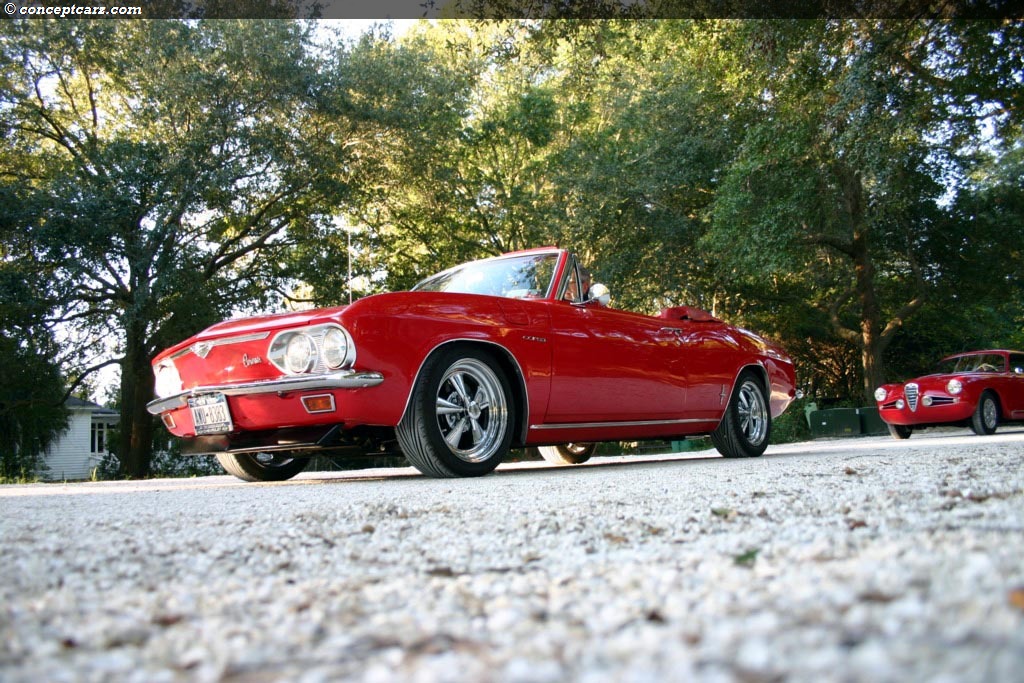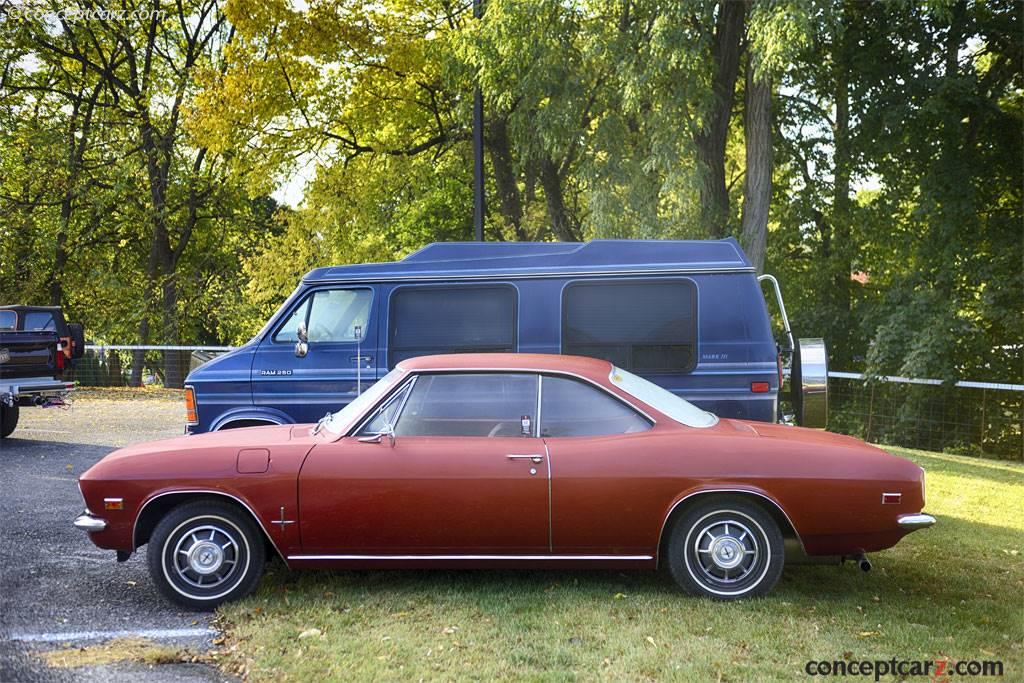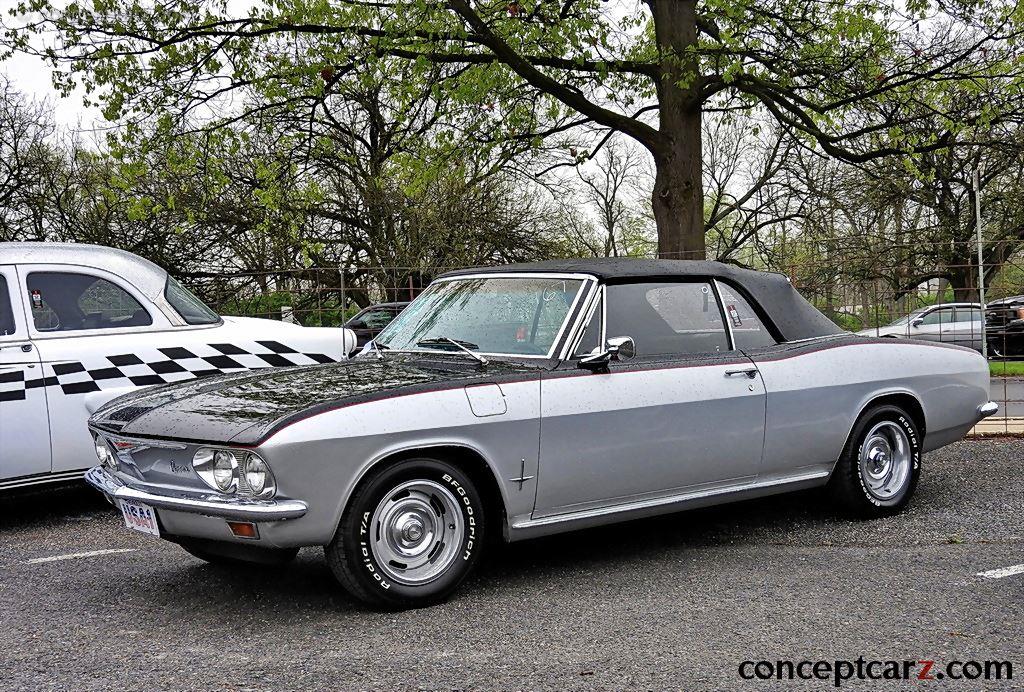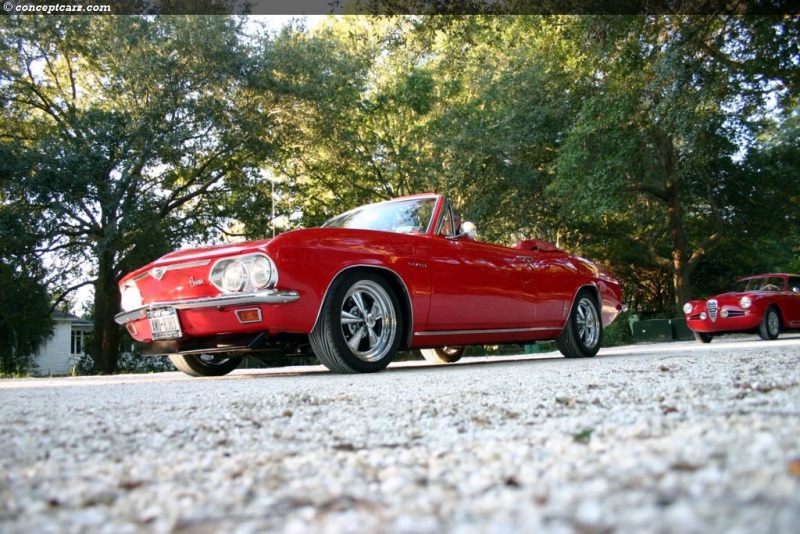With growing interest from the public for economic imports, Chevrolet introduced the compact and radical Corvair in 1960. Among the many unusual features were a rear-mounted, air-cooled six-cylinder engine and four-wheel independent suspension. Its status as an economy car quickly evolved to a low-priced sports car with the introduction of the bucket-seat-equipped Monza in 1961 followed by the turbocharged Monza Spyder in 1962. 
Monza Convertible
View info and historyIn 1965, General Motor's Bill Mitchell bestowed its first styling update, the only during its decade-long lifespan. It continued to use a 108-inch wheelbase, but the new Corvair was slightly larger than its predecessor. The sporty Corsa model was new to the lineup and came with 140 horsepower, 164 cubic-ich horizontally opposed, and an air-cooled six-cylinder with four, single-barrel carburetors. The engine was backed by a four-speed manual transmission, adding to its sporty persona. Body styles included both a convertible and coupe and 1966 was the Corsa's second and final year for what was the Corvair's most expensive model - priced at $2,662 before options. In total, Chevrolet built just 3,142 examples of the Corsa convertible for 1966. Corsa models had 'CORSA' lettering on the front fender above and behind the wheel opening and below the body feature line. There was a '140' emblem on the rear decklid, special 'C' center ornaments on the wheel covers and the steering wheel center, and special Corsa ornaments ahead of the rear wheel openings. The instrumentation included a tachometer, temperature, and oil pressure gauges. 1966 Corvair
The base trim level for the 1966 Corvair as the Corvair 500 Series 101 and offered as either a two-door hardtop sport coupe or a four-door Sport sedan. The coupe had a base price of $2,080 and the sedan listed for $2,160. 8,779 examples of the sedan were built and 24,045 of the coupes. The horizontally opposed overhead-valve six-cylinder engine had an aluminum block, four-main bearings, hydraulic valve lifters, two Rochester one-barrel carburetor, and delivered 95 horsepower at 3,600 RPM. A three-speed fully-synchromesh manual transmission was standard and a Powerglide automatic was optional in the 500 and Monza series. A four-speed manual transmission with floor shift controls was also optional.
Monza Hardtop Sport Coupe
Chassis #: 105376W109490
View info and history
Auction entries : 1The Corvair 500 rode on 7.00x 13 tries and had a padded dash, padded sun visors, two-speed wipers, windshield washers, back-up lights, coat hooks, locking glove box, rear seat belts, cigarette lighter, left outside rearview mirror, and interior lamps. The interior received more luxurious all-vinyl decor. Changes
The 1966 Corvair received a new one-piece rear grille and taillight assembly, narrower trim molding around the wheel openings, a wider front panel trim bar with a blue painted center section, and the Corvair signature was relocated back on the front panel. 1966 Corvair Monza
The Monza wore unique badges with the word 'Monza' on the lower front fender, additional chrome outline moldings around the rear deck panel, thin rocker panel moldings, and bright metal roof gutter trim and wheel covers. The interior had pleated upholstery with metal buttons, and standard equipment included front bucket seats, luggage compartment mat, fold-down rear seats on closed body styles, ashtrays in the front and rear, rear foam seat cushions, carpeting, and automatic dome and glovebox lights.
Corsa Convertible 07The Monza had the same body styles as the base 500 but added a convertible, priced at $2,490. The other two body styles were approximately $270 higher than the base 500 prices. 37,605 examples of the sport coupe were built, 12,497 of the sport sedan, and 10,345 of the convertible. 1966 Corvair Corsa
1966 was the final year for the Corsa, priced at $2,520 for the sport coupe and $2,660 for the convertible. 3,142 examples of the convertible were built and 7,330 of the sport coupe. Power was from an overhead-valve, 164 cubic-inch horizontally opposed six-cylinder engine with four main bearings, hydraulic valve lifters, four Rochester one-barrel carburetors with progressive linkage, and delivered 140 horsepower at 5,200 RPM. 'Corsa' front lettering was located on the front fender and there were special Corsa ornaments ahead o the rear wheel openings. In the back was a Satin Silver finished engine lid latch panel, and the wheel covers had special turbine-style center inserts with the Corsa badging in the middle. This badge could also be found on the unique steering wheel hub insert.
Corsa HardTop Sport Coupe
View info and historyThe Corsa came with the same level of standard equipment as the Monza plus an oil pressure gauge, temperature gauge, and a tachometer.Three special colors were offered in its final year, Chateau slate, Marina blue, Lemonwood yellow. These colors were available only on the Corsa or the Monza. Options
performance options available on the Monza and 500 Corvair including a 164 CID Turbo-Air engine, priced at $27, and delivering 110 horsepower. Monza and 500 models could be ordered with the 140 horsepower Turbo-Air engine, priced at $81. The Corsa could be fitted with a 164 CID six-cylinder unit with a turbocharger and 180 horsepower. Vehicle's with this option received an emblem that stated 'Turbocharger' and was located on the engine lid latch panel. Positive traction rear axle was a $38 option, various rear axle gear ratios were offered, and a heavy-duty 70-ampere batter cost $8. 500 and Monza, with air conditioning or the 140 horsepower engine, could be ordered with a heavy-duty air cleaner. Convenience options included an AM/FM push-button radio with front antenna, all-weather airconditioning, tinted glass, front or rear bumper guards, wheel covers, white sidewall tires, sport-stylee steering wheel, folding rear seat, seat belts with a retractor, spare wheel lock, and padded instrument panels (among others). Yenko Stinger
Don Yenko was a Corvette racer who was finding it difficult to compete successfully against Carroll Shelby's new GT350 in SCCA Production racing. Since the unconventional mid-engine configuration of the Corvair may offer a performance advantage, he decided to apply modifications to make it more competitive and to comply with SCCA regulations. At the time, the Corvair did not conform to any of the SCCA categories and modifications were necessary, including removing the rear seat. The SCCA required 100 cars to be manufactured to homologate the model for production racing, a task Yenko was able to accomplish in one month in 1965. They were all finished in white, as per the SCCA requirements for American cars at the time, but with numerous differences between each car. Some had fiberglass engine covers with spoilers, and various engine tunes were applied with output ranging from 160 to 240 hp. All examples used a heavy-duty suspension applied from the Chevrolet factory, along with a four-speed transmission, 'positraction' limited-slip differentials, dual brake master cylinders, and quicker steering ratio. The use of the dual brake master cylinders was the first by Chevrolet and would become standard equipment the following year. An oil cooler was added to aid in engine-cooling and was mounted externally on the rear body section above the left wheel. The first race for the Yenko Stinger was in January 1966, in the Class D production category, where it finished in second place by a mere second. By the close of the season, Dick Thompson had won the Northeast Division Championship, and Jerry Thompson had won the Central Division Championship and placed fifth in the 1966 Nationals.Chevrolet dropped the Corsa line after 1966 and initially, the Monza was not available with the four-carburetor engine from the factory. It later became available as a special performance option, along with the 3.89 differential. Since the Monza instrumentation did not include a head temperature or tachometer gauges, they needed to be installed separately. Colors included red or blue, as the SCCA had related its rules on color. The total production of 1967 Stingers is believed to be fourteen, along with three similar cars built for Dana Chevrolet, the U.S. West Coast distributor of Stingers. These three, built to Stinger specifications, also received the AIR injection section to comply with California emissions laws, with Yenko's blessing. The total production of all Stingers - all years - was 185 examples with the last example being YS-9700 built for Goodyear Tire and Rubber Company as a tire test vehicle in 1969.Concept Cars
Concept cars based on the Corvair included the Corvair SS, Monza GT, Monza SS, and Astro I. For the 1963 Geneva Motor Show, Giorgetto Giugiaro of Bertone created a one-off prototype called the 'Chevrolet Testudo.' Later, the Testudo was involved in a collision with the Bertone-designed Alfa Romeo Canguro, while on the track at the Monza circuit. Pininfarina built three concepts of the Corvair including the 'Corvair Speciale', 'Coupe I' and 'Coupe II.' The Corvair Monza GT and the Monza SS tourer around the country during early 1963, including being shown at the New York International Auto Show. The 1966 Electrovair II was based on a Monza 4-door hardtop and equipped with a 532 volt, 15-horsepower electric motor. It followed the 1964 Electrovair I concept and used silver-zinc batteries and the body was slightly modified to accept the drivetrain.
by Daniel Vaughan | Nov 2020

Monza Convertible
View info and history
The base trim level for the 1966 Corvair as the Corvair 500 Series 101 and offered as either a two-door hardtop sport coupe or a four-door Sport sedan. The coupe had a base price of $2,080 and the sedan listed for $2,160. 8,779 examples of the sedan were built and 24,045 of the coupes. The horizontally opposed overhead-valve six-cylinder engine had an aluminum block, four-main bearings, hydraulic valve lifters, two Rochester one-barrel carburetor, and delivered 95 horsepower at 3,600 RPM. A three-speed fully-synchromesh manual transmission was standard and a Powerglide automatic was optional in the 500 and Monza series. A four-speed manual transmission with floor shift controls was also optional.

Monza Hardtop Sport Coupe
Chassis #: 105376W109490
View info and history
Auction entries : 1
The 1966 Corvair received a new one-piece rear grille and taillight assembly, narrower trim molding around the wheel openings, a wider front panel trim bar with a blue painted center section, and the Corvair signature was relocated back on the front panel. 1966 Corvair Monza
The Monza wore unique badges with the word 'Monza' on the lower front fender, additional chrome outline moldings around the rear deck panel, thin rocker panel moldings, and bright metal roof gutter trim and wheel covers. The interior had pleated upholstery with metal buttons, and standard equipment included front bucket seats, luggage compartment mat, fold-down rear seats on closed body styles, ashtrays in the front and rear, rear foam seat cushions, carpeting, and automatic dome and glovebox lights.

Corsa Convertible 07
1966 was the final year for the Corsa, priced at $2,520 for the sport coupe and $2,660 for the convertible. 3,142 examples of the convertible were built and 7,330 of the sport coupe. Power was from an overhead-valve, 164 cubic-inch horizontally opposed six-cylinder engine with four main bearings, hydraulic valve lifters, four Rochester one-barrel carburetors with progressive linkage, and delivered 140 horsepower at 5,200 RPM. 'Corsa' front lettering was located on the front fender and there were special Corsa ornaments ahead o the rear wheel openings. In the back was a Satin Silver finished engine lid latch panel, and the wheel covers had special turbine-style center inserts with the Corsa badging in the middle. This badge could also be found on the unique steering wheel hub insert.

Corsa HardTop Sport Coupe
View info and history
performance options available on the Monza and 500 Corvair including a 164 CID Turbo-Air engine, priced at $27, and delivering 110 horsepower. Monza and 500 models could be ordered with the 140 horsepower Turbo-Air engine, priced at $81. The Corsa could be fitted with a 164 CID six-cylinder unit with a turbocharger and 180 horsepower. Vehicle's with this option received an emblem that stated 'Turbocharger' and was located on the engine lid latch panel. Positive traction rear axle was a $38 option, various rear axle gear ratios were offered, and a heavy-duty 70-ampere batter cost $8. 500 and Monza, with air conditioning or the 140 horsepower engine, could be ordered with a heavy-duty air cleaner. Convenience options included an AM/FM push-button radio with front antenna, all-weather airconditioning, tinted glass, front or rear bumper guards, wheel covers, white sidewall tires, sport-stylee steering wheel, folding rear seat, seat belts with a retractor, spare wheel lock, and padded instrument panels (among others). Yenko Stinger
Don Yenko was a Corvette racer who was finding it difficult to compete successfully against Carroll Shelby's new GT350 in SCCA Production racing. Since the unconventional mid-engine configuration of the Corvair may offer a performance advantage, he decided to apply modifications to make it more competitive and to comply with SCCA regulations. At the time, the Corvair did not conform to any of the SCCA categories and modifications were necessary, including removing the rear seat. The SCCA required 100 cars to be manufactured to homologate the model for production racing, a task Yenko was able to accomplish in one month in 1965. They were all finished in white, as per the SCCA requirements for American cars at the time, but with numerous differences between each car. Some had fiberglass engine covers with spoilers, and various engine tunes were applied with output ranging from 160 to 240 hp. All examples used a heavy-duty suspension applied from the Chevrolet factory, along with a four-speed transmission, 'positraction' limited-slip differentials, dual brake master cylinders, and quicker steering ratio. The use of the dual brake master cylinders was the first by Chevrolet and would become standard equipment the following year. An oil cooler was added to aid in engine-cooling and was mounted externally on the rear body section above the left wheel. The first race for the Yenko Stinger was in January 1966, in the Class D production category, where it finished in second place by a mere second. By the close of the season, Dick Thompson had won the Northeast Division Championship, and Jerry Thompson had won the Central Division Championship and placed fifth in the 1966 Nationals.Chevrolet dropped the Corsa line after 1966 and initially, the Monza was not available with the four-carburetor engine from the factory. It later became available as a special performance option, along with the 3.89 differential. Since the Monza instrumentation did not include a head temperature or tachometer gauges, they needed to be installed separately. Colors included red or blue, as the SCCA had related its rules on color. The total production of 1967 Stingers is believed to be fourteen, along with three similar cars built for Dana Chevrolet, the U.S. West Coast distributor of Stingers. These three, built to Stinger specifications, also received the AIR injection section to comply with California emissions laws, with Yenko's blessing. The total production of all Stingers - all years - was 185 examples with the last example being YS-9700 built for Goodyear Tire and Rubber Company as a tire test vehicle in 1969.Concept Cars
Concept cars based on the Corvair included the Corvair SS, Monza GT, Monza SS, and Astro I. For the 1963 Geneva Motor Show, Giorgetto Giugiaro of Bertone created a one-off prototype called the 'Chevrolet Testudo.' Later, the Testudo was involved in a collision with the Bertone-designed Alfa Romeo Canguro, while on the track at the Monza circuit. Pininfarina built three concepts of the Corvair including the 'Corvair Speciale', 'Coupe I' and 'Coupe II.' The Corvair Monza GT and the Monza SS tourer around the country during early 1963, including being shown at the New York International Auto Show. The 1966 Electrovair II was based on a Monza 4-door hardtop and equipped with a 532 volt, 15-horsepower electric motor. It followed the 1964 Electrovair I concept and used silver-zinc batteries and the body was slightly modified to accept the drivetrain.
by Daniel Vaughan | Nov 2020
Related Reading : Chevrolet Corvair History
magazine named it one of The 50 Worst Cars of All Time. Ralph Nader highlighted its design flaws in his influential book Unsafe at Any Speed. Yet the Chevrolet Corvair, which faced more negative press during its lifespan than any other car of the era, continues to have a loyal following of true enthusiasts. Different from any American cars before or since, the unique Corvair has become most....
Continue Reading >>
Continue Reading >>
Related Reading : Chevrolet Corvair History
The Corvair came on the scene in 1959 and featured a flat-six engine mounted in mid-ship. Even with putting the engine in the middle of the vehicle, the weight distribution was not evenly distributed. The engine sat behind the rear axle and this actually caused handling problems. The vehicles main competition was the VW Bug and the Porsche 911. It was originally built to compete with the Bug, but....
Continue Reading >>
Continue Reading >>
Chevrolet
Similarly Sized Vehicles
from 1966
Similarly Priced Vehicles
Chevrolet Monthly Sales Volume
March 2023
398,141
1966 Chevrolet Corvair Series Vehicle Profiles
Recent Vehicle Additions
Performance and Specification Comparison
Price Comparison
$2,025 - $2,500
$2,050 - $2,760
$2,185 - $2,965
$2,200 - $2,500
$2,300 - $3,000
$2,400 - $2,770
$2,480 - $2,950
$2,700 - $3,200
$2,994 - $3,297
$4,080 - $4,290
Corvair Specification Comparison by Year
Year
Production
Wheelbase
Engine
Prices
284,075
108.00 in.
6 cyl., 139.60 CID., 80.00hp
6 cyl., 144.99 CID., 98.00hp
6 cyl., 235.50 CID., 135.00hp
6 cyl., 144.99 CID., 98.00hp
6 cyl., 235.50 CID., 135.00hp
$1,915 - $2,325
301,999
108.00 in.
6 cyl., 144.99 CID., 80.00hp
6 cyl., 144.99 CID., 84.00hp
6 cyl., 144.99 CID., 150.00hp
6 cyl., 144.99 CID., 84.00hp
6 cyl., 144.99 CID., 150.00hp
$1,990 - $2,780
254,571
108.00 in.
6 cyl., 144.99 CID., 80.00hp
6 cyl., 144.99 CID., 80.00hp
6 cyl., 164.00 CID., 110.00hp
6 cyl., 144.99 CID., 80.00hp
6 cyl., 164.00 CID., 110.00hp
$1,990 - $2,800
2,046
108.00 in.
6 cyl., 144.99 CID., 80.00hp
6 cyl., 144.99 CID., 80.00hp
6 cyl., 164.00 CID., 110.00hp
6 cyl., 144.99 CID., 80.00hp
6 cyl., 164.00 CID., 110.00hp
199,387
108.00 in.
6 cyl., 163.60 CID., 95.00hp
6 cyl., 164.00 CID., 110.00hp
6 cyl., 164.00 CID., 150.00hp
6 cyl., 164.00 CID., 110.00hp
6 cyl., 164.00 CID., 150.00hp
$2,020 - $2,800
6 cyl., 164.00 CID., 155.00hp
152,577
108.00 in.
6 cyl., 164.00 CID., 95.00hp
6 cyl., 164.00 CID., 180.00hp
6 cyl., 164.00 CID., 180.00hp
$2,295 - $2,440
235,528
108.00 in.
6 cyl., 164.00 CID., 110.00hp
6 cyl., 230.00 CID., 140.00hp
6 cyl., 230.00 CID., 140.00hp
$2,025 - $2,600
103,743
108.00 in.
6 cyl., 164.00 CID., 95.00hp
6 cyl., 164.00 CID., 140.00hp
6 cyl., 164.00 CID., 140.00hp
$2,100 - $2,700
8,173
108.00 in.
6 cyl., 164.00 CID., 95.00hp
6 cyl., 164.00 CID., 110.00hp
6 cyl., 164.00 CID., 140.00hp
6 cyl., 164.00 CID., 110.00hp
6 cyl., 164.00 CID., 140.00hp
$2,500 - $2,630
Related Automotive News

Singer Presents Dynamics & Lightweighting Study - Turbo
Singers latest restoration services offered to enthusiast owners of the Type 964 air-cooled 911
Turbocharging integrated with the results of the Dynamics %26 Lightweighting Study (DLS)
Personalized at the request of Singers clients for road or tr...

DBZ Centenary Collection: Classic Joins Contemporary In Unique Centenary Tribute
DBZ Centenary Collection comprises of DB4 GT Zagato Continuation and DBS GT Zagato
Production strictly limited to 19 pairs - cars will not be sold separately
Conceived to mark Zagatos centenary in 2019
Track-only DB4 GT Zagato Continuation to be...

FROM SHELBYS TO SUPERCARS, RM SOTHEBY'S ARIZONA SALE OFFERS ICONIC COLLECTOR CARS OF EVERY ERA
Pure adrenaline 1965 Shelby 427 Competition Cobra, 1963 Shelby 289 Cobra Dragonsnake, and 1964 Shelby 289 Cobra lead recent entries for RM Sothebys Arizona Biltmore sale, January 28-29
Auction features more than 125 motor cars and offers incr...

CHRYSLER GROUP IN 2015, UNDER THE HOOD: MORE POWER, GREATER EFFICIENCY AND EXCEPTIONAL VALUE
Introducing the HEMI® Hellcat – Chrysler Groups most powerful V-8 ever 18th new engine added to Company lineup in less than five years
Celebrated TorqueFlite family grows by one with most robust eight-speed automatic in Chrysler Group history 15...

Holden Celebrates 35 Years of Commodore
Holden is celebrating the 35th anniversary of its most iconic nameplate, Commodore.
For over three decades, the Holden Commodore has delivered significant advances in vehicle performance, safety and comfort on the way to becoming Holdens longest-standing...






























